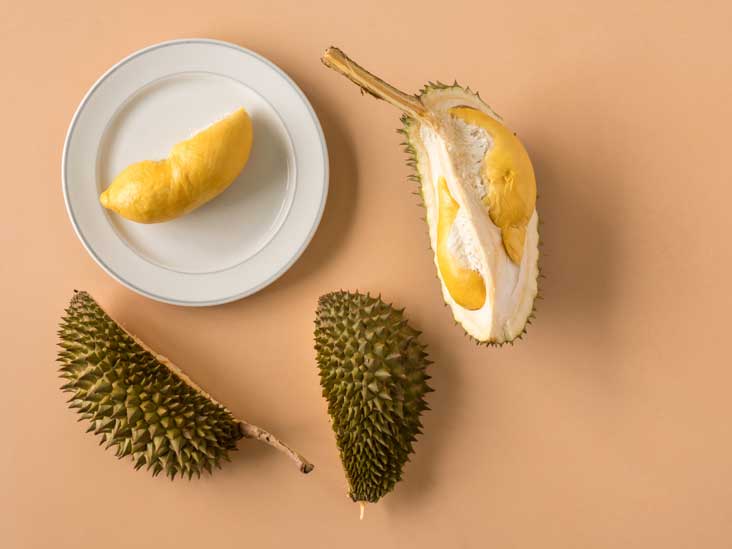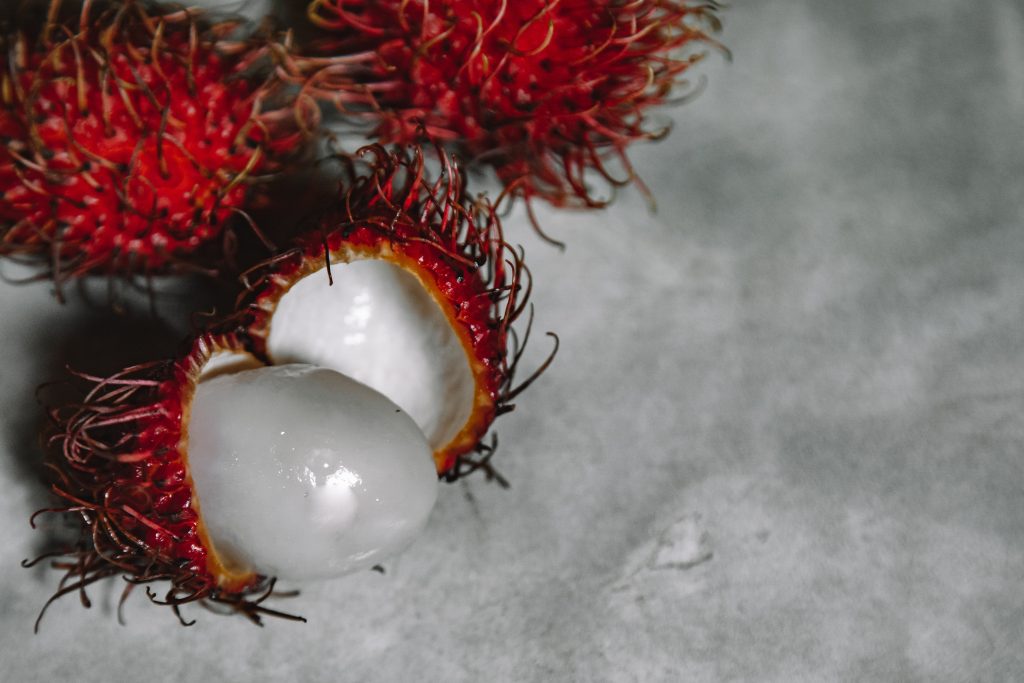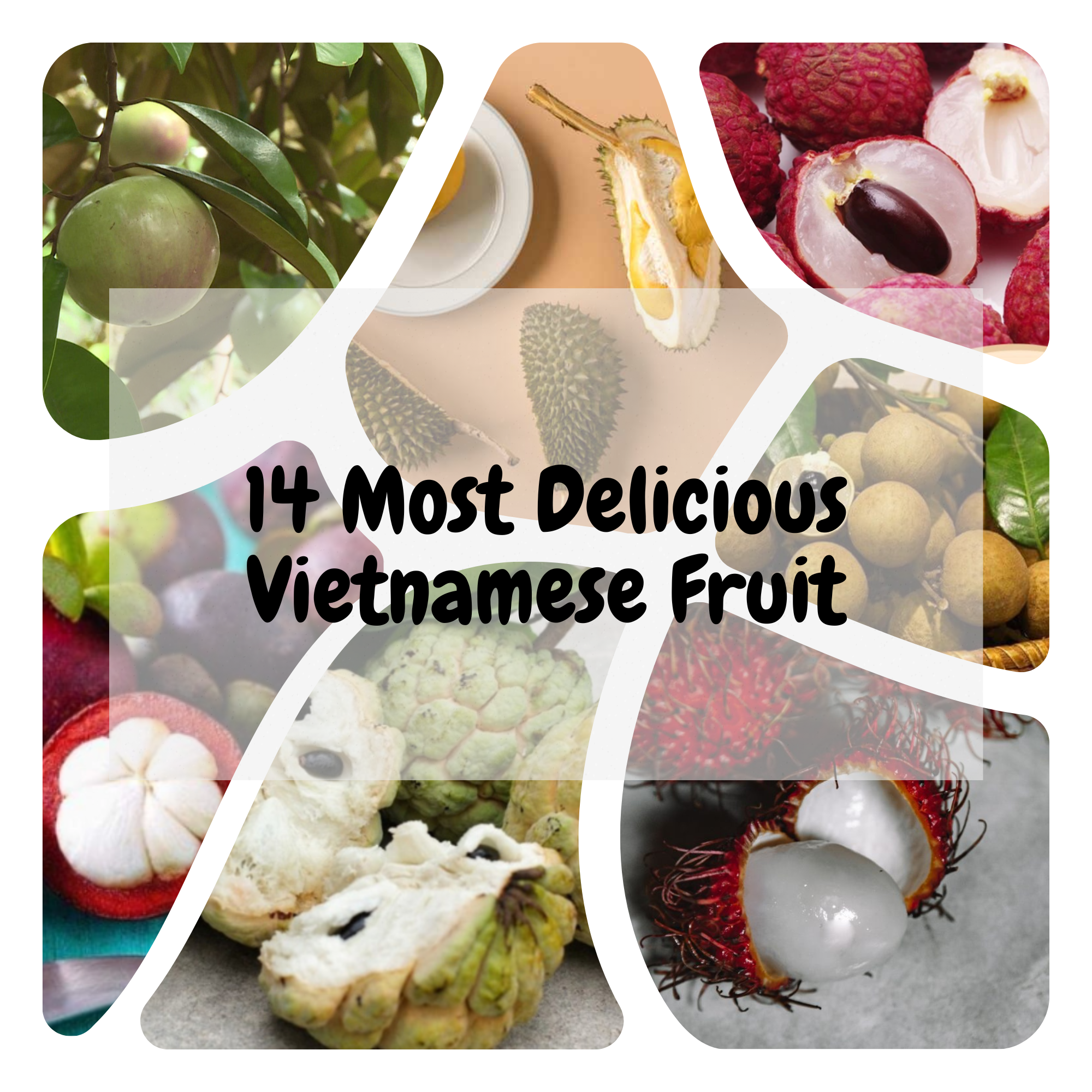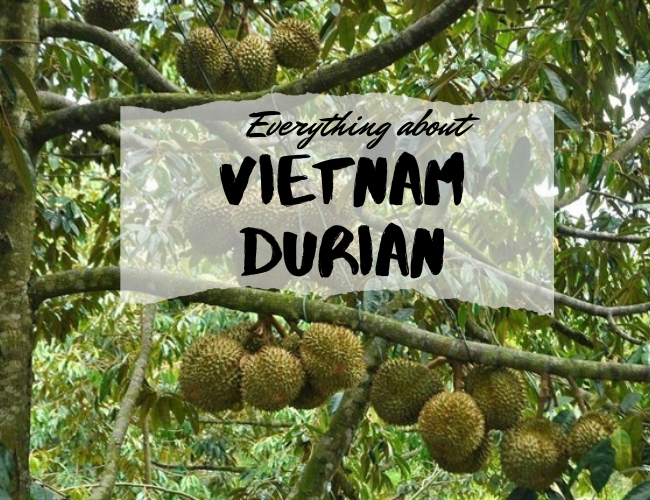Located in the tropical region, Vietnam boasts a diversity of fruits. Many types of Vietnamese fruit differ in shape, colour, and taste, which always wows foreign visitors. Keep on reading to learn 14 of the most praised fruits in Vietnam, their taste, their price, where and when to buy them, and how to eat them.
1. Durian

Durian, dubbed as ‘king of fruit’ in many Southeast Asian countries, is famous (or notorious) for its aroma. It is so strong that you can recognize it from far away and can linger in your hand for a long time after eating. Even many people detest this aroma. However, the taste is loved by most eaters. They describe it as custardy and almond-flavoured.
The best time to buy durians is from June to August. You can find this Vietnamese fruit in markets, supermarkets, and fruit stores. Usually, the prices range from 55,000 to 60,000 VND (~ $2.35-$2.50) per kg.
How To Eat:
Mostly, people eat fresh durian after opening. Others make them into sweet dishes such as durian sweet soups, durian sticky rice, and durian ice cream.
>> Read more: Vietnam Durian: A Fruit With Special Taste
2. Rambutan

This Vietnamese fruit is in the same family as longan and lychee fruits. When ripe, the cover turns red and the flesh is jelly-like, translucent, and juicy with a sweet and slightly sour taste.
Rambutan season is from May to July, which is the best time to buy this fruit. If you eat it at another time of the year, the fruit might be toxic as it contains chemicals that stimulate it to mature unseasonably. You can buy rambutan in open markets or roadside stalls and usually in bunches. It costs about 25,000-35,000 VND per kg.
How To Eat:
Peeling the skin to eat the flesh is how to eat a rambutan. Most people prefer using a knife to cut the skin in half.
3. Custard Apple

Custard apple is mostly cultivated in the south-central region of Vietnam. This unique fruit features a bumpy green skin covering translucent flesh, which is delicate, light, and sweet.
During the summer months, especially from July to August, eaters can find this Vietnamese fruit in almost all local markets. The average price fluctuates between 50,000 and 70,000 VND per kg.
How To Eat:
It’s quite tricky for people to try this fruit for the first time. The easiest way is to cut the fruit into pieces and use a spoon to remove the seeds and skin from the flesh.
4. Lychee

Lychee is not only preferred as a snack in Vietnam but also in other Asian countries like China. Though the flesh texture is similar to that of rambutan, lychee tastes a bit sweeter and has a different aroma.
Lychee season begins in May and ends in September. You can buy this Vietnamese fruit during this period, and from street stalls, open markets, and supermarkets. It costs from 30,000 to 70,000 VND per kg, depending on the species and region.
How To Eat:
Most people eat lychee fresh. They use bare hands to peel the thin skin. Lychee can also be made into sweet dishes such as sweet soups.
5. Longan

Considered a royal fruit, longan used to be dedicated only to the kings in the past. In today’s world, Vietnamese people eat this summer fruit every day. Longan is a relative to lychee, which is why the texture of their flesh is fairly similar. Yet, longan is sweeter and has more flesh than lychee. The seed inside the flesh is hard and inedible.
Longan matures all year round. You can easily find them sold in bunches on street stalls, local markets, and several supermarkets. It costs around 20,000 VND per kg.
How To Eat:
Usually, longan is eaten fresh. You can easily peel the thin skin with your hands to reveal the flesh. Another way is to use longan as an ingredient in some dishes, such as longan and lotus seed sweet soup.
6. Mangosteen

Cultivated across the Cai Mon, Bao Loc, and Lai Thieu provinces of Vietnam, the mangosteen tree bears fruits once in 8-15 years. This partly accounts for its high expense.
Under the thick and dark purple skin lies pale white segments like those of a tangerine or an orange. They are irresistibly sweet with a light sour taste.
You can enjoy mangosteen from May to August. It is usually found on fruit stalls in markets and supermarkets. This Vietnamese fruit is significantly expensive, with a price of 40,000 to 50,000 VND per kg.
How To Eat:
People in Vietnam usually eat mangosteen fresh, using a knife to cut the skin in half. Some people can break it with bare hands. Besides, mangosteen can be canned or dried for longer preservation.
7. Milk Fruit/Star Apple

Also called star apple, milk fruit is very juicy, with creamy flesh and thick milky juice under a thin skin. The flesh tastes like coconut water but sweeter. Its Vietnamese name is ‘vu sua’, meaning breast milk, a beautiful description of the fruit juice.
Milk fruit season is from December to January. Even in its season, it is hard to find due to low yield yet high maintenance. It is more popular in local markets and reasonably priced at around 20.000 VND per kg.
How To Eat:
Ideally, you cut the fruit into segments and enjoy them (except the skin). An interesting way is to cut a hole in it and drink the milky juice from it.
8. Mango

This fruit is popular not only in Vietnam but also around the globe. It tastes sweet when ripe and sour when unripe.
In Vietnam, mango mostly matures from April to July. It can be found almost everywhere, from small markets to big supermarkets. The prices range from 15,000 to 25,000 VND per kg and can be higher.
How To Eat:
Besides enjoying the fruit when it’s ripe, Vietnamese people love to eat unripe and green mango with chilli salt. You can find mango (at different levels of ripeness) in dishes like sweet soups or green mango salad.
9. Jackfruit

Almost as large and thorn-covered as durian, jackfruit is popular in Southeast Asia. The flesh is bright yellow, chewy, crunchy, and as sweet as candies.
You can buy this Vietnamese fruit in local markets and even some supermarkets from March to June or from April to September. Each kilo of jackfruit costs about 30,000 VND.
How To Eat:
To eat a whole fresh jackfruit, you need to cut it open with a big knife and separate the flesh from the threads and the seeds. The seeds are also edible, usually after boiling. The threads are also used in some savoury Vietnamese dishes.
10. Soursop

Like durian and jackfruit, soursop is another thorn-covered fruit, but in a smaller size. Under the skin lies the white pulp which is irresistibly sweet and a bit sour. It tastes like a banana, pineapple, and grape.
Soursop season is from January to February and April to May when it can mostly be found in local markets. Its price is around 30,000 to 40,000 VND per kg.
How To Eat
When ripe, this Vietnamese fruit is soft and can be easily pulled apart by hand. Remember to remove the small seeds before eating. Soursop can also be an ingredient in sweet soups, ice cream, or candies.
11. Dragon Fruit

Cultivated mostly in Binh Thuan, a dry province in Vietnam, dragon fruit has a unique vibrant pink skin and a light and sweet taste, like pear or watermelon.
During its season, from April to October, you can buy this Vietnamese fruit in local markets. Each kilo costs around 20,000 VND.
How To Eat:
Basically, Vietnamese people usually cut it into segments and enjoy it (except the skin), or make it into smoothies.
12. Starfruit/Carambola

There are two types of starfruit: sweet and sour (when ripe!). The flesh is golden yellow, soft, and very juicy. When cut horizontally, each slice is star-shaped, which explains its name.
Starfruit season can be all year round, but unpredictable. People usually sell it in local markets and small fruit stalls beside the street. Each kilo costs around 20,000-30,000 VND.
How To Eat:
With careful rinse before cutting them into pieces, you can enjoy sweet starfruit with its extremely thin skin. Sour starfruit is usually used in savoury dishes, like fish soup.
13. Pomelo

Closely related to grapefruit, pomelo is a large citrus fruit. Under a thick skin lies light yellow or pink fruit, which tastes mildly sweet and a bit bitter.
You can find this Vietnamese fruit from August to December, in markets and less often in supermarkets. Each kilo of pomelo costs 40,000-60,000 VND per kg.
How To Eat:
You can eat pomelo in the same way you eat grapefruit. Peel the thick skin and enjoy the segments. The white inner part of the skin is cooked as an ingredient of pomelo sweet soup, a favoured dessert in Vietnam.
14. Guava

This is a superfruit due to its high nutrients. It looks like a pear and is as big as a baseball. The outer is the green skin covering the white or pink flesh. When ripe, it tastes mildly sweet and light. It can be a little bit bitter if it’s not fully ripe.
This fruit matures all year round in Vietnam, and you can buy it from markets to supermarkets. This is an inexpensive Vietnamese fruit, with 10,000-20,000 VND per kg.
How To Eat:
People usually eat it fresh, both when ripe and nearly ripe. After a careful rinse, you cut it into segments and enjoy it. Many Vietnamese people prefer eating nearly ripe guava with chilli salt, creating a mixture of a sweet, salty, spicy, and slightly bitter taste.
Final Thoughts
The variety of Vietnamese fruit is too big to be covered in just one article. Some other unique and worth-trying fruits in Vietnam are sapodilla, blackberry, pineapple, and dracontomelon. If you have a chance to visit this S-shaped country, don’t leave without trying some of the fruits on this list!


